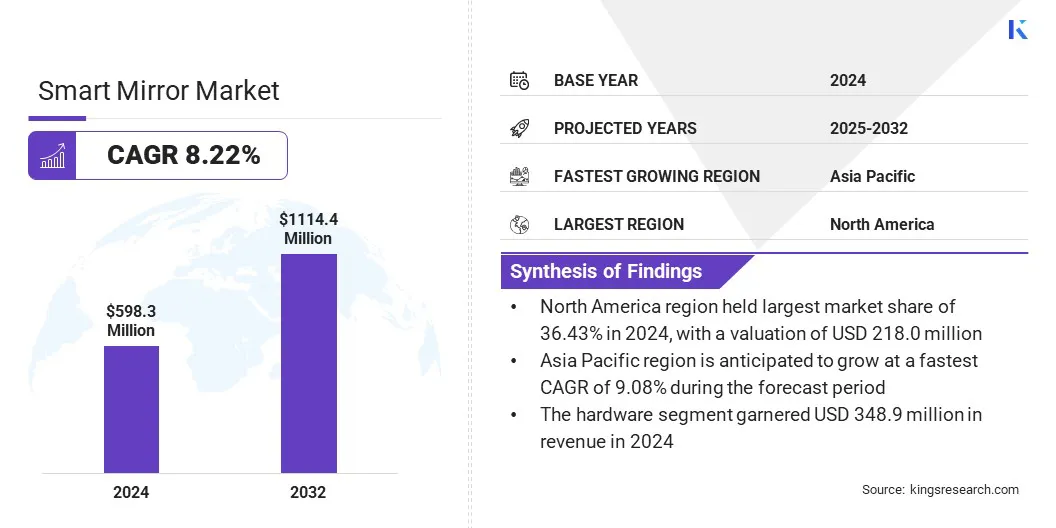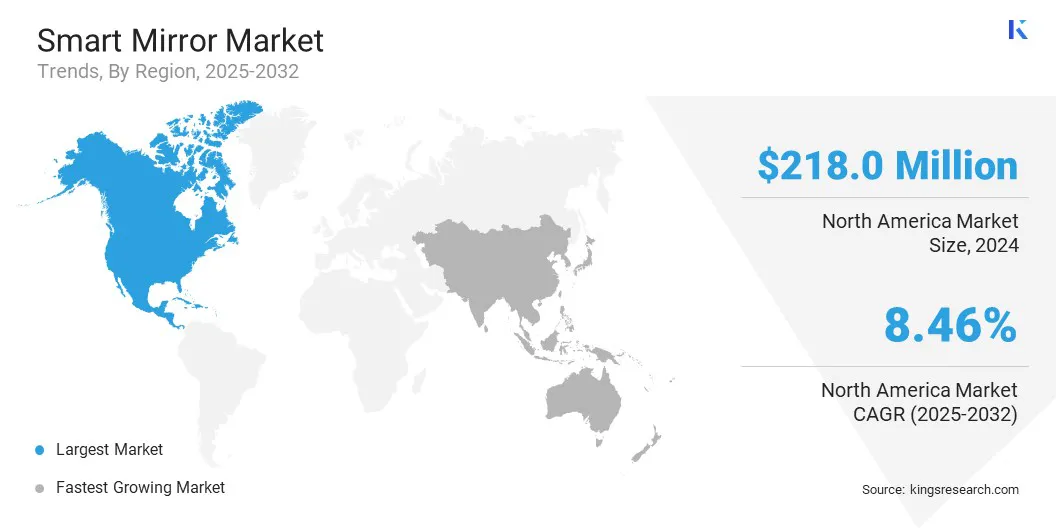Market Definition
A smart mirror is an interactive reflective surface integrated with digital technologies such as displays, sensors, and connectivity features. The market includes components like hardware and services. It covers various installation types, including wall-mounted and free-standing units. Key end user industries include automotive, retail and advertising, smart homes or residential, and healthcare.
Smart Mirror Market Overview
The global smart mirror market size was valued at USD 598.3 million in 2024 and is projected to grow from USD 641.1 million in 2025 to USD 1,114.4 million by 2032, exhibiting a CAGR of 8.22% during the forecast period.
This growth is attributed to the growing demand for smart mirrors from the automotive industry, where manufacturers are integrating advanced digital mirrors to enhance safety and driver assistance features. There is a significant shift toward health monitoring and disease risk assessment, with smart mirrors increasingly equipped to track vital signs and support preventive care.
Major companies operating in the market are Capstone Companies Inc., Alke, Portl, DIRROR, Ficosa Internacional SA, Mirrocool, Dension, FFFACE.ME, Kohler Co., Foshan Stan Household Technology Co., Ltd., Séura, Withings, Keonn Technologies, S.L., Artforma, and Samsung Electronics.
Companies are advancing smart mirror technology by enhancing reflectance and transmittance capabilities, enabling clearer visibility and the seamless integration of digital displays. These improvements allow mirrors to function effectively under varying lighting conditions while maintaining high optical quality.
Manufacturers are also incorporating personalized beauty insights through AI-powered skin analysis, facial recognition, and real-time feedback. These features are being adopted in personal care, retail, and professional salon environments to deliver customized user experiences and increase product engagement.

Key Highlights:
- The smart mirror industry size was valued at USD 598.3 million in 2024.
- The market is projected to grow at a CAGR of 8.22% from 2025 to 2032.
- North America held a market share of 36.43% in 2024, with a valuation of USD 218.0 million.
- The hardware segment garnered USD 348.9 million in revenue in 2024.
- The wall-mounted segment is expected to reach USD 538.1 million by 2032.
- The automotive segment is expected to reach USD 331.9 million by 2032.
- The market in Asia Pacific is anticipated to grow at a CAGR of 9.08% during the forecast period.
Market Driver
Growing Demand for Smart Mirrors in The Automotive Industry
The smart mirror market is driven by the growing demand from the automotive industry. Automakers are increasingly integrating smart mirrors equipped with digital displays, cameras, and advanced driver assistance features to improve safety and visibility.
These systems replace traditional mirrors with high-resolution screens that provide real-time views of blind spots, rear traffic, and surrounding environments. Smart mirrors have become a key component in next-generation automotive design as vehicle manufacturers focus on enhancing driver awareness and reducing distractions.
- In June 2025, Tata Motors launched the Harrier.ev, which features an advanced HD Rear View Mirror (e-IRVM) that functions as a smart mirror. The mirror provides an unobstructed digital view regardless of obstructions and includes built-in dashcam functionality, recording in Full HD at front and rear angles.
Market Challenge
High Production Costs Limiting Widespread Adoption of Smart Mirrors
A major challenge in the smart mirror market is high production costs that are associated with advanced components such as sensors, displays, and connectivity modules. These costs make smart mirrors less accessible for price-sensitive consumers and limit large-scale adoption across residential and mid-range commercial applications.
Mmanufacturers are focusing on cost optimization through component standardization and streamlined manufacturing processes. Companies are also partnering with technology suppliers to reduce input costs and improve economies of scale, enabling more competitive pricing in the market.
Market Trend
Shift Toward Health Monitoring and Disease Risk Assessment
The smart mirror market is registering a shift toward the integration of technologies that enable vital sign monitoring and disease risk assessment. Manufacturers are developing mirrors with embedded sensors and imaging systems that measure heart rate, breathing patterns, and other physiological indicators. These smart mirrors are being used in residential and healthcare settings to support early detection and preventive care.
AI-based analytics enhance the accuracy of these assessments and provide users with real-time health insights. This shift reflects growing interest in non-invasive wellness solutions integrated into everyday environments.
- In January 2024, NuraLogix launched Anura MagicMirror, a tabletop smart mirror designed to measure health vitals by analyzing facial blood flow patterns. The device, powered by the DeepAffex Affective AI platform, marks the company’s first manufactured product and enables vital sign monitoring and disease risk assessments.
Smart Mirror Market Report Snapshot
|
Segmentation
|
Details
|
|
By Component
|
Hardware (Displays, Sensors, Cameras, Others), Services
|
|
By Installation Type
|
Wall-mounted, Free-standing
|
|
By End User Industry
|
Automotive, Retail & Advertising, Smart Homes/Residential, Healthcare, Others
|
|
By Region
|
North America: U.S., Canada, Mexico
|
|
Europe: France, UK, Spain, Germany, Italy, Russia, Rest of Europe
|
|
Asia-Pacific: China, Japan, India, Australia, ASEAN, South Korea, Rest of Asia-Pacific
|
|
Middle East & Africa: Turkey, U.A.E., Saudi Arabia, South Africa, Rest of Middle East & Africa
|
|
South America: Brazil, Argentina, Rest of South America
|
Market Segmentation
- By Component (Hardware (Displays, Sensors, Cameras, Others), and Services): The hardware segment earned USD 348.9 million in 2024, due to the growing demand for integrated display and sensor components in connected devices.
- By Installation Type (Wall-mounted and Free-standing): The wall-mounted segment held 53.16% share of the market in 2024, due to its widespread use in retail, hospitality, and residential settings for space-efficient installation.
- By End User Industry (Automotive, Retail & Advertising, Smart Homes/Residential, Healthcare, and Others): The automotive segment is projected to reach USD 331.9 million by 2032, owing to the rising adoption of smart rearview and side-view mirrors that enhance driver safety and support advanced driver-assistance systems.
Smart Mirror Market Regional Analysis
Based on region, the market has been classified into North America, Europe, Asia Pacific, Middle East & Africa, and South America.

North America accounted for a Smart Mirror market share of 36.43% in 2024, with a valuation of USD 218.0 million. This dominance is attributed to technological advancements, especially the integration of smart TV features into mirror systems.
High consumer demand for multifunctional connected devices and strong investment in home automation have supported their adoption. Leading manufacturers in the region continue to focus on innovation, which has strengthened the region’s dominance in the global market.
- In September 2024, Séura launched its next-generation Smart TV Mirrors, featuring the Vanishing Technology and newly developed 4K UHD TV panels tailored for mirror integration. The new models deliver a 70% increase in brightness and include a smart operating system for access to streaming services, along with Air Mouse remote control functionality.
The smart mirror industry in Asia Pacific is poised to grow at a CAGR of 9.08% over the forecast period. The growth is primarily attributed to the increased adoption of smart mirrors in the automotive sector.
Rising vehicle production across China, Japan, and South Korea has accelerated the demand for advanced driver assistance systems and digital mirrors. Government support for smart mobility and expanding automotive exports has further contributed to the market growth across the region.
Regulatory Frameworks
- In the U.S., smart mirrors used in automotive applications must comply with regulations set by the National Highway Traffic Safety Administration (NHTSA), particularly Federal Motor Vehicle Safety Standards (FMVSS) No. 111, which governs rear visibility and mirror performance.
- In Europe, smart mirrors integrated into vehicles are regulated under the UNECE Regulation No. 46, which outlines requirements for devices used to provide indirect vision, including digital mirrors.
Competitive Landscape
Key players in the global smart mirror industry are focusing on product innovation, strategic partnerships, and technology integration to strengthen their market position. Companies are increasingly developing smart mirrors that support mental wellness features, such as mood tracking, guided meditation, and personalized wellness insights, to cater to evolving consumer preferences.
Key players are investing in artificial intelligence, voice recognition, and IoT connectivity to enhance the functionality and interactivity of their products. Companies are expanding their offerings through modular designs that allow seamless integration with home automation systems and connected appliances. These strategies have enabled key players to maintain a strong competitive position and address diverse application needs across industries.
- In January 2024, Baracoda introduced BMind at CES 2024, presenting it as the first AI-driven smart mirror focused on mental wellness. Developed using the CareOS platform, BMind delivers tailored mental health support by recognizing user mood and managing stress through voice control, gesture detection, and intent recognition.
List of Key Companies in Smart Mirror Market:
- Capstone Companies Inc.
- Alke
- Portl
- DIRROR
- Ficosa Internacional SA
- Mirrocool
- Dension
- FFFACE.ME
- Kohler Co.
- Foshan Stan Household Technology Co., Ltd.
- Séura
- Withings
- Keonn Technologies, S.L.
- Artforma
- Samsung Electronics
Recent Developments (Product Launch)
- In January 2025, Samsung Electronics launched the MICRO LED Beauty Mirror at First Look 2025 in the U.S. The smart mirror features advanced reflectance and transmittance technology combined with personalized beauty insights. It analyzes individual skin types to offer tailored product recommendations, enhancing self-care routines.


